Regional Education Contacts
Paleontology is a lively area of research, and media coverage of new discoveries creates a sense of excitement about our field in students and the general public. As part of the Paleontological Society’s mission to advance the science of paleontology, we encourage paleontologists to engage the public, the media, government officials, P-16 educators and their students to promote understanding of the importance of paleontological research.
The following Paleontological Society members have volunteered to serve as regional resources for the public, the media, local and state governments, and P-16 educators and their students. These scientists have agreed to field general questions in paleontology; each paleontologist’s more specific areas of expertise are also listed.
Please contact a resource person directly to gather basic paleontological information or solicit expert feedback on paleontological questions. Note that the views expressed by these scientists are their own, and do not necessarily reflect the official position of the Paleontological Society.
The Paleontological Society hopes that you will take advantage of this opportunity to communicate with active researchers in our field.
NORTHEASTERN
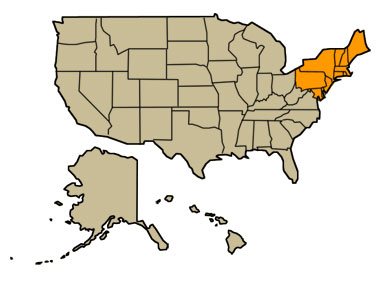
In the United States: Connecticut, Delaware, District of Columbia, Maine, Maryland, Massachusetts, New Hampshire, New Jersey, New York, Pennsylvania, Rhode Island, Vermont. In Canada: New Brunswick, Newfoundland and Labrador, Nova Scotia, Prince Edward Island, Quebec, Ontario east of the 89th meridian.
Ronald McDowell
Senior Research Geologist
Head of Geoscience Section
West Virginia Geological and Economic Survey
Email
Topics: Trace fossils, bedrock mapping and environmental interpretation
Mike Meyer
Researcher and Keck Project Manager
Geophysical Laboratory
Carnegie Institution for Science, Washington, D.C.
Email
Topics: General paleontology, geobiology, paleoecology, trace fossils, early life, development of complex and Ediacaran life, taphonomy, advanced analytical methods such as CT, SEM and RAMAN
D. Jeffrey Over
Professor
Department of Geological Sciences
State University of New York, Geneseo
Email
Topics: Invertebrate paleontology, micropaleontology, mass extinctions, sequence stratigraphy
Jonathan Wilson
Associate Professor
Department of Environmental Studies
Haverford College, Pennsylvania
Email
Topics: Paleobotany, paleoecology, mathematical methods, evolution
SOUTHEASTERN
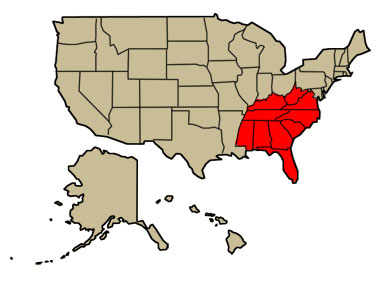
In the United States: Alabama, Florida, Georgia, Kentucky, Mississippi, North Carolina, South Carolina, Tennessee, Virgina, West Virginia, Puerto Rico. In Mexico: Campeche, Quintana Roo, Yucatán.
David Campbell
Associate Professor
Geology
Gardner-Webb University, North Carolina
Email
Topics: Invertebrates, evolution
Cynthia Crane
Director
Aurora Fossil Museum
Aurora, North Carolina
Email
Topics: Vertebrate paleontology, taphonomy, sedimentology
Michael Gibson
Professor
Department of Agruculture, Geosciences and Natural Resources
University of Tennessee, Martin
Email
Topics: Invertebrate paleontology, marine paleoecology and geology, geoscience education
Steven Hageman
Professor
Department of Geology
Appalachian State University, North Carolina
Email
Topics: Paleozoic fossils, Appalachian geology
Andrew B. Heckert
Professor
Department of Geology
Appalachian State University, North Carolina
Email
Topics: Triassic, vertebrate paleontology, microvertebrates, reptiles
NORTH CENTRAL
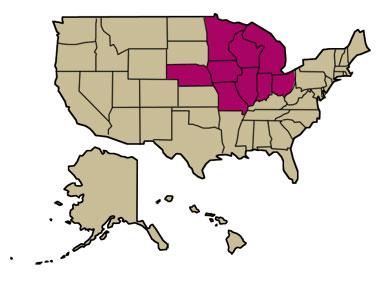
In the United States: Illinois, Indiana, Iowa, Michigan, Minnesota, Missouri, Nebraska, Ohio, Wisconsin. In Canada: Manitoba, Ontario west of the 89th meridian.
R.A. Davis
Professor
Biology
College of Mount St. Joseph, OH
Email
(513) 244-4699
Topics: Marine Invertebrates, Cephalopods, organic evolution, General paleontology
Rodney Feldmann
Professor Emeritus
Geology
Kent State University, OH
Email
(330) 672-2506
Topics: Marine invertebrate fossils, Antarctic paleontology, Fossil decapod crustaceans from New Zealand, Antarctica, Patagonia, Romanian, Jurassic evolutionary explosion of fossil crabs
Website
Daniel Hembree
Associate Professor
Geological Sciences
Ohio University, OH
Email
(740) 597-1495
Topics: Trace fossils, Paleosols, Vertebrate paleontology
Roy Plotnick
Professor
Earth and Environmental Sciences
University of Illinois at Chicago, IL
Email
(312) 996-2111
Topics: Paleoecology, Macroevolution, Mathematical methods, Marine invertebrates, Chicago area geology
Website
Carrie Schweitzer
Professor
Geology
Kent State University, OH
Email
(330) 244-3303 or (330) 672-2505
Topics: Decapoda, Crustacea excluding Ostracoda, Marine Invertebrates, Evolution, Paleogene
Website
Alycia Stigall
Professor
Geological Sciences
Ohio University, OH
Email
(740) 593-0393
Topics: Marine invertebrates, Cincinnati fossils, Mass extinction, Evolution, Biogeography
Website
Margaret Yacobucci
Professor
Geology
BGSU, OH
Email
(419) 372-7982
Topics: Fossil cephalopods (ammonites), Marine invertebrate animals, Evolution, Cretaceous Period, Undergraduate science education
SOUTH CENTRAL
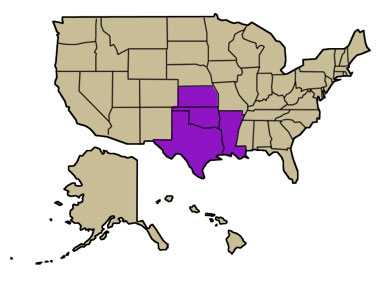
In the United States: Arkansas, Kansas, Louisiana, Oklahoma, Texas. In Mexico: Coahuila, Nuevo León, Tabasco, Tamaulipas, Veracruz.
Rena M. Bonem
Professor and Director of Undergraduate Studies in Geology
Department of Geosciences
Baylor University, Texas
e-mail: [email protected]
Topics: Invertebrate paleontology, modern and ancient reefs, Texas dinosaur trackways
Ryan Morgan
Associate Professor
Department of Chemistry, Geology and Physics
Tarleton State University, Texas
e-mail: [email protected]
Topics: Invertebrate identification, burrows, dinosaur tracks, evolution, preservation, Cretaceous
ROCKY MOUNTAIN
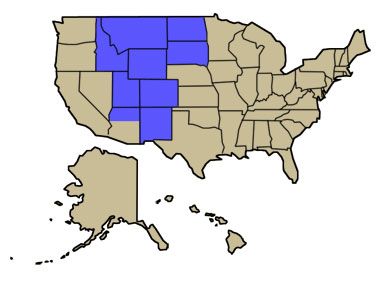
In the United States: Arizona north of lat 35°N, Colorado, Idaho, Montana, New Mexico, North Dakota, South Dakota, Utah, Wyoming. In Canada: Alberta, Saskatchewan. In Mexico: Chihuahua.
Benjamin Burger
Associate Professor
Department of Geology
Utah State University, Vernal
email: [email protected]
Topics: Vertebrate paleontology, fossil mammals, dinosaurs, evolutionary processes, Cenozoic-Mesozoic fossils, geology of Colorado, southern Wymoing and eastern Utah
David Elliott
Professor
School of Earth Sciences and Environmental Sustainability
Northern Arizona University
Flagstaff, Arizona
email: [email protected]
Topics: General paleontology, vertebrate paleontology, Paleozoic jawless vertebrates
Karl Osvald
Senior Geologist
U.S. Department of Interior/ Bureau of Land Management
Casper, Wyoming
e-mail: [email protected]
Topics: Vertebrate paleontology
Darrin Pagnac
Associate Professor
Department of Geology and Geological Engineering
South Dakota School of Mines and Technology
email: [email protected]
Topics: Vertebrate paleontology, general paleontology, evolution, taphonomy, Great Plains and Rocky Mountain sedimentary geology
Daniel Peppe
Professor
Department of Geosciences
Baylor University
email: [email protected]
Topics: Paleobotany, paleoclimate, paleoecology, evolution, stratigraphy, paleomagnetism, Cretaceous, K-T boundary, Paleogene, Cenozoic
David Varricchio
Professor
Department of Earth Sciences
Montana State University
e-mail: [email protected]
Topics: Dinosaurs, Cretaceous, taphonomy
CORDILLERAN

In the United States: Alaska, Arizona south of lat 35°N, California, Hawaii, Nevada, Oregon, Washington. In Canada: British Columbia, Yukon Territory, Northwest Territories, Nunavut Territory. In Mexico: Distrito Federal, Aguascalientes, Baja California, Baja California Sur, Chiapas, Colima, Durango, Guanajuato, Guerrero, Hidalgo, Jalisco, México State, Michoacán, Morelos, Nayarit, Oaxaca, Puebla, Querétaro, San Luis Potosí, Sinaloa, Sonora, Tlaxcala, Zacatecas.
David R. Greenwood
Professor
Department of Biology and J.R. Brodie Science Centre
Brandon University, Canada
e-mail: [email protected]
Topics: Fossil leaves, paleobotany, paleoclimates, Tertiary; Canadian paleontology, especially British Columbia and Nunavut
Matthew Clapham
Professor
Department of Earth and Planetary Sciences
University of California, Santa Cruz
e-mail: [email protected]
Topics: Marine invertebrates, paleoecology, mass extinctions
Elizabeth Nesbitt
Curator and Professor
Burke Museum, and Earth and Space Sciences Department
University of Washington, Seattle
e-mail: [email protected]
Topics: Pacific Northwest invertebrate faunas, foraminifera, museum outreach
Gary D. Webster
Emeritus Professor of Geology
School of the Environment
Washington State University
email: [email protected]
Topics: General paleontology, invertebrate paleontology especially echinoderms, evolution, fossils through time, paleogeography
|







